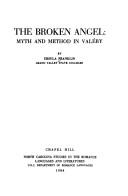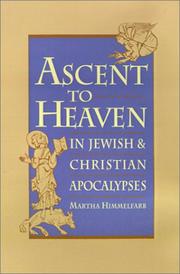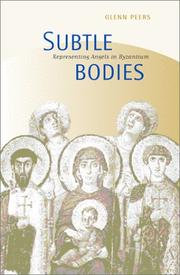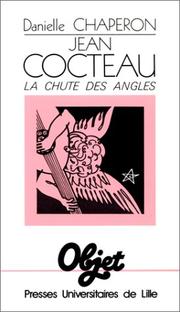| Listing 1 - 5 of 5 |
Sort by
|

ISBN: 1469642662 9781469642666 9780807892268 0807892262 Year: 1984 Publisher: Chapel Hill U.N.C. Dept. of Romance Languages
Abstract | Keywords | Export | Availability | Bookmark
 Loading...
Loading...Choose an application
- Reference Manager
- EndNote
- RefWorks (Direct export to RefWorks)

ISBN: 1280526769 0195359658 1429401206 9781429401203 9780195359657 9780195082036 0195082036 9781280526763 0195082036 0197738257 Year: 1993 Publisher: New York : Oxford University Press,
Abstract | Keywords | Export | Availability | Bookmark
 Loading...
Loading...Choose an application
- Reference Manager
- EndNote
- RefWorks (Direct export to RefWorks)
This is a comparative study of the ancient Jewish and Christian views of the ascent into heaven. It places the ascent narratives in their cultural and historical context, and explores their relationship to the canonical apocalypses and to other Graeco-Roman literature of ascent and divinization.
Apocalyptic literature --- Voyages to the otherworld in literature. --- Heaven. --- Angels in literature. --- Future life --- History and criticism. --- Heaven --- Christianity --- History of doctrines. --- Judaism --- Bible.

ISBN: 9786612356308 0520925130 1282356305 1597349240 9780520925137 1417523840 9781417523849 9780520224056 0520224051 9781597349246 6612356308 0520224051 9781282356306 Year: 2001 Publisher: Berkeley University of California Press
Abstract | Keywords | Export | Availability | Bookmark
 Loading...
Loading...Choose an application
- Reference Manager
- EndNote
- RefWorks (Direct export to RefWorks)
Throughout the course of Byzantine history, Christian doctrine taught that angels have a powerful place in cosmology. It also taught that angels were immaterial, bodiless, invisible beings. But if that were the case, how could they be visualized and depicted in icons and other works of art? This book describes the strategies used by Byzantine artists to represent the incorporeal forms of angels and the rationalizations in defense of their representations mustered by theologians in the face of iconoclastic opposition. Glenn Peers demonstrates that these problems of representation provide a unique window on Late Antique thought in general.
Church history --- Angels in literature. --- Angels in art. --- Angels --- Iconoclasm --- Christianity --- Angels (Buddhism) in art --- Idols and images --- Biblical teaching. --- History. --- Middle Ages, 600-1500 --- History --- Worship --- Orthodox Eastern Church --- Byzantine Empire --- Church history. --- Orthodox Eastern Church -- Byzantine Empire -- History.. --- Iconoclasm -- Byzantine Empire -- History.. --- Angels -- Biblical teaching.. --- Angels in art.. --- Angels in literature.. --- Church history -- Middle Ages, 600-1500.. --- Byzantine Empire -- Church history. --- aesthetics. --- ancient world. --- angels in art. --- angels in literature. --- angels. --- archangel. --- art. --- barberini diptych. --- bible. --- bodies. --- byzantine art. --- byzantium. --- cherub. --- cherubim. --- church doctrine. --- divinity. --- early christian theology. --- early church. --- embodiment. --- folk belief. --- folk religion. --- greece. --- hagiography. --- hellenism. --- iconoclasm. --- icons. --- literature. --- madonna. --- magritte. --- michael. --- middle ages. --- religion. --- religious practices. --- saints legends. --- saints lives. --- saints. --- sarcophagus. --- theology. --- unrepresentable. --- virgin and child.

ISBN: 2859393730 2757426133 9782859393731 Year: 1991 Publisher: Lille Presses universitaires de Lille
Abstract | Keywords | Export | Availability | Bookmark
 Loading...
Loading...Choose an application
- Reference Manager
- EndNote
- RefWorks (Direct export to RefWorks)
La poésie de Cocteau est le résultat d’une apparition, mieux, d’une annonciation où la parole coïncide avec une insémination phénoménologique. L’ange de cette annonciation est issu d’un univers parallèle, d’un au-delà de la conscience, des sens, du temps et de l’espace. Le poète est tantôt le provocateur, tantôt la victime, d’une sorte de transgression des limites sensorielles. Imaginaire de la perception psychique et cosmique : une invisible lutte avec la menace ou la tentation de sa visibilité possible, un ange s’égare hors de l’imperceptible, hors de l’inconscient. Cocteau configure à l’aide d’images empruntées à la science la répartition entre les mondes humains et angéliques et les variations de leur accessibilité réciproque. Il s’inspire dans le désordre des recherches sur la lumière, la relativité, la quatrième dimension, les ultrasons, la Chronophotographie, l’atome... L’ange est le paradigme d’un phénomène happé ou séduit par un dispositif, rendu perceptible par machine. Mais il s’invente un visage de monstruosité, de « montrabilité », opération qui seule le fait exister dans le mensonge, le langage, le manque. L’ange tel qu’il apparaît dans la scène de l’annonciation est amputé de toute sa folle richesse. La rencontre qui se voudrait amoureuse avec le poète est donc toujours insatisfaisante. L’homme ne peut que castrer cette merveille érotique à la mesure fatale de ses organes, de sa logique. Le poète est alors amené à ériger, sans joie, la matérialité de sa propre écriture en fétiche : objet artificiel mais sans défaillance.
Cocteau, Jean --- Angels in literature --- Anges dans la littérature --- Cocteau, Jean, --- Anges dans la littérature --- Poetic works --- Criticism and interpretation --- Critique et interprétation --- Cocteau, Jean, - 1889-1963 - Poetic works --- Poetic works. --- Literature (General) --- poésie --- angle --- phénomènologie --- montrabilité --- Kokto, Zhan, --- Cocteau, Clément Eugène Jean Maurice, --- Kokutō, Jan, --- קוקטו, ז׳אן, --- コクトージャン, --- Cocteau, Jean, - 1889-1963
Book
ISBN: 1442688327 9781442688322 9780802097927 0802097928 9781442692619 1442692618 Year: 2008 Publisher: Toronto, Ont. University of Toronto Press
Abstract | Keywords | Export | Availability | Bookmark
 Loading...
Loading...Choose an application
- Reference Manager
- EndNote
- RefWorks (Direct export to RefWorks)
In the Anteroom of Divinity focuses on the persistence of Pseudo-Dionysian angelology in England's early modern period.
English literature --- Angels in literature. --- Angels --- Christianity and literature --- Reformation --- English Reformation --- Angelology --- Cherubim --- Cherubs (Spirits) --- Divine messengers --- Seraphim --- Spirits --- History and criticism. --- History of doctrines. --- History --- Pseudo-Dionysius, --- pseudo-Dionysius Areopagita --- Dionysius Areopagita --- Denys l'Aréopagite --- Denys the Areopagite --- Dionysius de Areopagiet --- Dionysius --- Influence. --- Thematology --- Pseudo-Dionysius the Areopagite --- anno 1500-1599 --- anno 1600-1699 --- England. --- Angleterre --- Anglii͡ --- Anglija --- Engeland --- Inghilterra --- Inglaterra --- Dionigi, --- Dionisiĭ, --- Dionisio, --- Dionysios, --- Dionysius Areopagita, --- Dionysius Mysticus --- Dionysius, --- Pseudo-Denys, --- Pseudo-Dionigi, --- Pseudo-Dionisiĭ, --- Pseudo Dionisio, --- Psevdo-Dionise, --- Psevdo-Dionisii︠a︡,
| Listing 1 - 5 of 5 |
Sort by
|

 Search
Search Feedback
Feedback About UniCat
About UniCat  Help
Help News
News